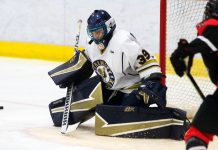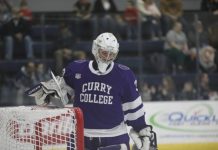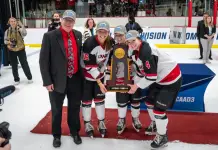“Amazing.”
It was a word USA Hockey president Ron DeGregorio used many times to sum up the USA Hockey Level 5 Masters Symposium that was held in late August in Washington D.C.
He also used it to describe the USA Hockey Coaching Education Program and its accomplishments. He couldn’t have picked a better word; the program has become one that is emulated by other sports organizations across the United States. It is a program that has certified over 55,000 coaches in the U.S. and is on the verge of bestowing its highest level, Masters, on 500 new coaches if they meet the requirements needed for that level. There are just under 1,900 Masters-level coaches in the USA Hockey program (I’m proud to be one of them).
“This is a program that started many years ago and the CEP was a first step to influence and educate people in the U.S. on what development should be,” said DeGregorio, known as Digger to the hockey community in which he so actively participates as a player, coach and administrator.
DeGregorio was the last of the USA Hockey brass to speak at the symposium and his rousing speech to the assembled body on a Sunday morning was as much an update on the progress of the CEP and the American Development Model as it was a motivational speech to the coaches in attendance. The message was clear: They are the next wave of coaches to develop future American players for Junior A, prep school, Minnesota high school, NCAA and possibly pro hockey.
DeGregorio furthered the thought.
“Coaches have a lot of responsibility and we have a responsibility to support them with all that we do with coaching clinics, teaching aids and printed material,” said DeGregorio, a former Middlebury goaltender. “We also have to support the parents, the rink owners, the associations. Change is always taking place, and when it does it has to be for the right reasons.”
The ADM is the core of what USA Hockey is about in terms of developing American-born players from the East Coast to Alaska. Its high-tempo, structured, and focus-on-the-basics approach has proven successful. Its off-ice component, based on years of research and observation of the world’s best hockey-playing countries, has laid the groundwork for players to improve away from the rink.
“The framework of the ADM is scientifically proven, but a lot of it is common sense,” said DeGrgorio, referring to the age-specific skills taught to players at the time they are best prepared to handle them. “You don’t train brain surgeons at 8 years old. We put people in danger when we accelerate development at the wrong ages.”
DeGregorio has plenty of experience in watching players develop at the youth level. He was first elected to the board of directors of what was then the Amateur Hockey Association of the United States in 1975 and was the organization’s first director of youth hockey.
“We want to get to our kids with the right skills at the right time,” he said. “When we do that we see that they have an easier time and are quicker to adapt to them as they get older.”
The symposium featured several high-level coaches from the pro level that got their starts with USA Hockey and have been part of the coaching staffs of USA Hockey teams at all levels. Among the heavy hitters in Washington was former Hobey Baker Award winner George McPhee, now in his 15th year as general manager of the Washington Capitals. Providence star Brian Burke, GM of the 2010 U.S. Olympic Team and president/GM of the Toronto Maple Leafs was also a featured speaker who spoke on the role of the coach in an organization. Ron Rolston, Tim Army, Joe Sacco, Dan Bylsma, John Hynes, Mike Sullivan and AHL championship coach Jon Cooper were among the speakers.
ADM regional managers ran breakout sessions that included off-ice training, long-term athlete development, goaltending development and age-specific training for age groups and 13 and up.
Pee Wee body contact and the proper technique to teach checking were huge topics and it was obvious that many coaches at the youth level still were unsure what the parameters are and factors were in the removal of body checking at Pee Wee. USA Hockey made sure to emphasize the agenda of small-area games as part of a curriculum that encourages body contact at all levels and helps teach the fundamentals of effective checking.
“The biggest change in the game is speed,” said McPhee, the keynote speaker on the opening night. “You really have to be able to move out there. Speed has also increased the hitting in our game; there are more hits every year. I thought the ’70s and ’80s were physical; it is nothing compared to how physical it is now.”
McPhee was no stranger to the physical game and a visit to YouTube could prove that. After playing at Bowling Green under Jerry York, McPhee went onto a career in the NHL mostly with the New York Rangers.
He has a son who played at the Pee Wee level last year, so he got to watch a number of the games. He compared it to the games he saw at that level in past years to prove that the rule eliminating the big hit at the Pee Wee level was a great idea in both the U.S. and Canada.
“Kids were playing scared and you can’t teach fear,” McPhee said during a 60-minute question-and-answer session with the coaches after his presentation. “You can always teach someone to hit but there is never enough time to teach skill. Minus the hitting and intimidation, games at the Pee Wee level are faster and more competitive now than ever. The physical play at young levels became too big a factor and it wasn’t being done right.”
Burke is no stranger to truculent play. He likes the game rough and tumble and told the assembled crowd just what he expects physically from his Toronto Maple Leafs, which is no different than what he wanted in Vancouver and Anaheim. He wants contact in all three zones. He wants opponents to tread lightly when they play his teams, especially in Toronto.
He did make a point about hitting that seemed to really grip the coaches in attendance who hung literally on his every word.
“Hitting is the lowest athletic skill we teach,” said Burke, who won a Stanley Cup as the GM in Anaheim in 2007. “We were seeing a drop-off in players at the Pee Wee level, and hitting was a major reason. Science tells us that Bantam is the right age to start really hitting. There are two things you can’t replace: eyes and brains. Brains were being injured in Pee Wee.”
The CEP has grown by leaps and bounds in recent years and credit for that goes to the 13 regional coaches-in-chief and the two men responsible for the CEP, Mark Tabrum and Mike MacMillan. Their goal is to properly equip those who are on the bench and running the practices and to do it in a way that keeps the coaches’ costs low and their returns high.
Burke, in talking about those in the trenches of the CEP, said it best: “The linchpin of the system in the United States is the volunteer coach.”
Tabrum, a former assistant coach at Colorado College, has been at the helm of the CEP since 2000. In his time the program has gone from something amateur coaches felt they participated in because they had to to a program that is as good if not better than any in the world when it comes to teaching coaches how to coach well.
MacMillan has been the national coach-in-chief for two years. He was USA Hockey’s Minnesota district coach-in-chief from 1995 to 2010, and just think how many great players were developed in that state in that era. Some of those great players came from him in his 30-plus years as a high school coach in the State of Hockey.
“The last three years this program has really evolved,” said MacMillan, a former Division III-level goalie. “The Level 1-4 courses are more progressive. There is better flow from one into the other. We made it like college courses, like Hockey 101, Hockey 201, etc.”
The emphasis under MacMillan and Tabrum has been to retool the clinics for Levels 1 through 3 and the materials available to coaches. Instead of having coaches watch videos or go over things that were very basic in an anaesthetic medium, those who attend these clinics are treated to state-of-the-art presentations. They include the latest video, up-to-date teaching techniques and slides with all the teaching points on that particular skill or subject.
Taking a bold step with the help of program coordinators Matt Cunningham, Dan Brennan and assisted by Alison Raines, USA Hockey invited all of their CEP instructors (of which I am one) to re-training seminars both last summer and this summer. New materials in printed and visual form were distributed to the instructors and we were all put through a typical ADM practice on the ice run by the ADM managers. Getting the coaches into a practice as players, in effect making them kids again, was a stroke of brilliance and reinvigorated those who might have forgotten how much fun a good practice can be for players.
“We reached out to the 13 CICs and they drove the change in how we administered the CEP,” said the well-spoken MacMillan, who helps in symposiums all over the U.S. “We had our affiliate presidents get info at the grassroots level from coaches on what we needed to do better to help them and it really drove us to be better.”
The emphasis is on the material now at the 1-3 level. Presenters at levels 4 and 5 can still create their own presentations. The computer presentations, all on flash drives, can be constantly tinkered with, updated, changed and re-sent to the instructors via email. A USA Hockey coaches app for smartphones and tablets will soon be available so coaches will have access to the latest drills and vital info in an instant.
The common misnomer among former players that played at a high level is that they might not need “remedial” courses in hockey. That could not be farther from the truth.
“Knowing the game and playing the game are not the same thing. Having a good player and knowing how to be a good player does not necessarily correlate to being a good teacher of the game,” MacMillan said. “We have all seen average players or guys who didn’t play much become great coaches and some great players fail as coaches. Mike Keenan, Scotty Bowman and Ken Hitchcock all won Stanley Cups as a coach without much of a playing background.
“These ex-players along with those who love the game need to come back and learn how to teach kids, how to develop programs, how to coach. Our program at the Level 1-3 is so comprehensive it covers everything you need to become a good coach and we also teach you how to implement the ADM into your practice regimen. It is a lot of information and it is designed to teach coaches to teach kids.”
USA Hockey has made a huge effort to reach out to players finishing their NCAA or junior career and get them interested in coaching. Players are comfortable on the playing side and the jump to taking off the sweater and putting on the track suit and whistle can be intimidating at first.
“There is no reward without risk,” MacMillan said. “You have to lay it out there. You have to adapt to the new challenge. These guys have the passion for the game. We are showing them a new way to use it for the betterment of hockey in the United States. Coaching is like playing a big game every day. It is a constant challenge. We prepare them for it and we have had a lot of success with it.”
The coaches that were in attendance are mostly volunteers at the youth level but there were college coaches there as well, including both assistants from Robert Morris.
“I used to think coaching was overrated,” McPhee said as he completed his remarks. “Now I think it is underrated. Coaches are vital to your success.”


